Collection of materials relating to neuro-ophthalmology as part of the Neuro-Ophthalmology Virtual Education Library.
NOVEL: https://novel.utah.edu/
TO
- NOVEL728
| Title | Creator | Description | Subject | ||
|---|---|---|---|---|---|
| 51 |
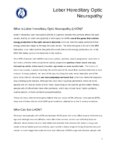 |
Hereditary Optic Neuropathy (Leber's Hereditary Optic Neuropathy) | NANOS | Hereditary Optic Neuropathy - A hereditary optic neuropathy is caused by a genetic variant (or mutation) that causes dysfunction of the neurons (nerve cells) which form the optic nerve. The optic nerve sends information from the back of the eye to the vision center in the brain.The two most common t... | Hereditary Optic Neuropathy; Patient Brochure |
| 52 |
 |
Transient Vision Loss | NANOS | Vision loss that is temporary (transient) is a common problem and has many potential causes.Patients with temporary vision loss often do not have any abnormalities on their eye examination, especially once the vision has returned to normal. | Transient Vision Loss; Patient Brochure |
| 53 |
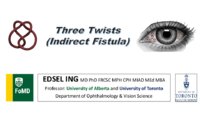 |
Indirect Carotid Cavernous Fistula | Edsel Ing, MD, PhD, FRCSC | A 67-year-old woman had delayed initial diagnosis of her right low flow carotid cavernous fistula (CCF) during the coronavirus disease (COVID-19) pandemic due to difficulty detecting ocular signs via online virtual examinations. Her right eye conjunctival erythema and proptosis with medial rectus en... | Carotid Cavernous Fistula; Misdiagnosis; Radiology |
| 54 |
 |
Giant Cell Arteritis: Diagnostic Prediction Models, Temporal Artery Biopsy and Epidemiology | Edsel Ing MD, PhD FRCSC MPH CPH MIAD MEd MBA, | Giant cell arteritis (GCA) is the most common primary vasculitis in the elderly and can cause irreversible blindness, aortitis, and stroke. Diagnostic confirmation of GCA usually entails temporal artery biopsy (TABx) - a time-consuming and invasive test, or ultrasound. The primary treatment of GCA i... | Giant Cell Arteritis; Diagnostic Prediction Model; Epidemiology; Temporal Artery Biopsy; Differential Diagnosis |
| 55 |
 |
Corectopia | Meagan Seay, DO | These are photos of a patient with unilateral corectopia. This patient's corectopia is of unclear etiology and possibly related to birth trauma. | Corectopia; Unilateral; Photos |
| 56 |
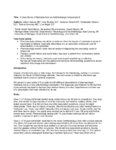 |
A Case Series of Mydriasis from an Anticholinergic Antiperspirant | Aileen Antonio, MD; Inna Bondira, DO; Cameron Holicki, DO; Christopher Glisson, DO; Tatiana Deveney, MD; Lina Nagia, DO | Causes of anisocoria span a wide range, from benign to life-threatening, making it a common indication for Neuro-Ophthalmology referrals. One such cause is related to pharmacologic mydriasis due to direct or systemic exposure. We present a case series of four patients with different presentations of... | Anisocoria; Mydriasis; Pharmacologic Anisocoria; Anticholinergic Antiperspirant |
| 57 |
 |
Anatomic and Physiologic Basis for Gaze Stability | Ariel Winnick and Meagan Seay, DO | Diagram describing the anatomic and physiologic basis of gaze stability. | Gaze Stability |
| 58 |
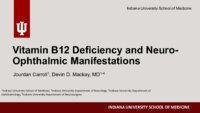 |
Vitamin B12 Deficiency and Neuro-Ophthalmic Manifestations | Jourdan Carroll; Devin D. Mackay, MD | This presentation covers vitamin B12 deficiency, including etiology, signs and symptoms, neurologic and ophthalmic findings, a case presentation and treatment. | Vitamin B12 Deficiency and Neuro-Ophthalmic Manifestations |
| 59 |
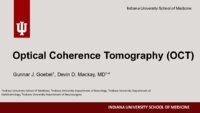 |
Optical Coherence Tomography (OCT) | Gunnar J. Goebel; Devin D. Mackay, MD | Introduction to OCT, including history, principles, interpretation, and applications. | Optical Coherence Tomography (OCT) |
| 60 |
 |
How to Find Funding Sources | Elizabeth Frakes, MLIS, AHIP | Brief description of funding sources and how to find them. | Funding |
| 61 |
 |
How to Submit an IRB Application | Elizabeth Frakes, MLIS, AHIP | A general outline of the steps involved in submitting an IRB application for research. | Institutional Review Board (IRB) |
| 62 |
 |
A Macro Dilemma: Demonstrations of the Anterior Chiasmal Syndrome and Wilbrand's Knee | Ariel Axelbaum, MD; Nurhan Torun, MD | Presentation reviewing two cases that demonstrate several cases of anterior chiasmal syndromes and the variability in patient presentations with sellar masses. | Anterior Chiasmal Syndromes; Masses of the Sella |
| 63 |
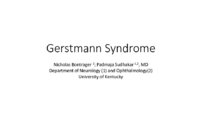 |
Gerstmann Syndrome | Nicholas Bontrager; Padmaja Sudhakar, MD | Gerstmann syndrome refers to a constellation of four neurologic deficits: agraphia, acalculia, finger agnosia , and left-right disorientation. All symptoms must be present for a diagnosis of true Gerstmann syndrome. | Gerstmann Syndrome |
| 64 |
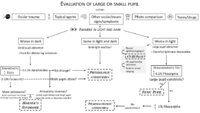 |
Pupil Evaluation Flowchart | Ariel Winnick; Eric Caskey, MD; Meagan Seay, DO | Flow chart outlining the evaluation of large or small pupils. | Pupil Evaluation |
| 65 |
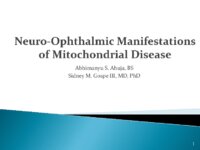 |
Neuro-Ophthalmic Manifestations of Mitochondrial Disease | Abhimanyu S. Ahuja, BS; Sidney M. Gospe III, MD, PhD | Classically, mitochondrial diseases exhibit a maternal inheritance pattern because pathogenic mutations in mitochondrial DNA (mtDNA) are transmitted exclusively via the maternal lineage due to rapid degradation of sperm-derived mitochondria early in embryogenesis. However, mutations in mtDNA may occ... | Mitochondrial Disease; Pathophysiology |
| 66 |
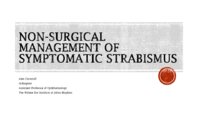 |
Non-Surgical Management of Strabismus | Alex Christoff, MD | An overview of non-surgical treatment of strabismus. | Strabismus |
| 67 |
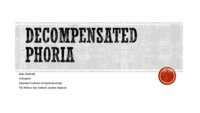 |
Decompensated Phoria | Alex Christoff, MD | An overview of decompensated phoria and its treatment. | Decompensated Phoria |
| 68 |
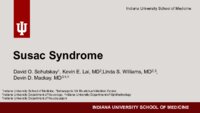 |
Susac's Syndrome | David O. Sohutskay; Kevin E. Lai, MD; Linda S. Williams, MD; Devin D. Mackay, MD | Overview of a case of Susac Syndrome. | Susac Syndrome |
| 69 |
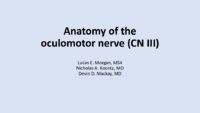 |
Anatomy of the Oculomotor Nerve (CN III) | Lucas E. Morgan, MS4; Nicholas A. Koontz, MD; Devin D. Mackay, MD | A detailed overview of the anatomic course of CN III, including a detailed pathway description and labeled MRI images, gross anatomy pictures, and structural models. | CN III; Third Cranial Nerve; Oculomotor Nerve; Anatomy; MRI |
| 70 |
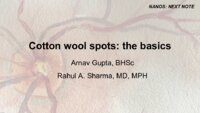 |
Cotton Wool Spots: The Basics | Arnav Gupta, BHSc; Rahul Sharma, MD, MPH | A presentation describing cotton wool spots, an abnormal finding on funduscopic exam of the retina of the eye. | Cotton Wool Spots; Retina |
| 71 |
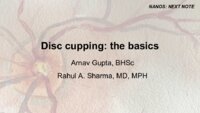 |
Disc Cupping: The Basics | Arnav Gupta, BHSc; Rahul Sharma, MD, MPH | A presentation describing optic disc cupping, due to damage of optic nerve fibres. | Disc Cupping; Optic Disc |
| 72 |
 |
Progressive Supranuclear Palsy (PSP) | Molly Cincotta, MD; Ali G. Hamedani, MD, MHS | Objectives:; To provide an overview of PSP and its pathophysiology;; To present typical clinical features of the disease with a focus on ocular findings;; To provide a template for work up, diagnosis and treatment; ; To demonstrate typical eye movement abnormalities seen in PSP | Progressive Supranuclear Palsy (PSP) |
| 73 |
 |
Computed Tomography (CT): Principles, Technique, and Neuro-ophthalmic Applications | Alex Fraser, MD | Presentation covering Computed Tomography principles, adverse effects, comparison vs. MRI, and assorted examples of neuro-ophthalmic interest. | Computed Tomography (CT) |
| 74 |
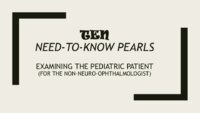 |
Examining the Pediatric Patient for Non-Neuro-ophthalmologists | John Pula, MD | Ten need-to-know pearls for examining the pediatric patient, for non-neuro-ophthalmologists. | Pediatric Patient Exam |
| 75 |
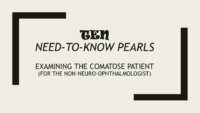 |
Examining the Comatose Patient for Non-Neuro-ophthalmologists | John Pula, MD | Seven need-to-know pearls for examining the pediatric patient, for non-neuro-ophthalmologists. | Comatose Patient Exam |
